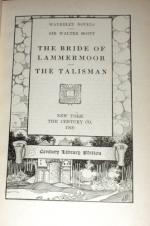It was said by a constant tradition that a Malisius de Ravenswood had, in the 13th century, been deprived of his castle and lands by a powerful usurper, who had for a while enjoyed his spoils in quiet. At length, on the eve of a costly banquet, Ravenswood, who had watched his opportunity, introduced himself into the castle with a small band of faithful retainers. The serving of the expected feast was impatiently looked for by the guests, and clamorously demanded by the temporary master of the castle. Ravenswood, who had assumed the disguise of a sewer upon the occasion, answered, in a stern voice, “I bide my time”; and at the same moment a bull’s head, the ancient symbol of death, was placed upon the table. The explosion of the conspiracy took place upon the signal, and the usurper and his followers were put to death. Perhaps there was something in this still known and often repeated story which came immediately home to the breast and conscience of the Lord Keeper; for, putting from him the paper on which he had begun his report, and carefully locking the memoranda which he had prepared into a cabinet which stood beside him, he proceeded to walk abroad, as if for the purpose of collecting his ideas, and reflecting farther on the consequences of the step which he was about to take, ere yet they became inevitable.
In passing through a large Gothic ante-room, Sir William Ashton heard the sound of his daughter’s lute. Music, when the performers are concealed, affects us with a pleasure mingled with surprise, and reminds us of the natural concert of birds among the leafy bowers. The statesman, though little accustomed to give way to emotions of this natural and simple class, was still a man and a father. He stopped, therefore, and listened, while the silver tones of Lucy Ashton’s voice mingled with the accompaniment in an ancient air, to which soem one had adapted the following words:
“Look not thou
on beauty’s charming,
Sit thou still when
kings are arming,
Taste not when the wine-cup
glistens,
Speak not when the people
listens,
Stop thine ear against
the singer,
From the red gold keep
they finger,
Vacant heart, and hand,
and eye,
Easy live and quiet
die.”
The sounds ceased, and the Keeper entered his daughter’s apartment.
The words she had chosen seemed particularly adapted to her character; for Lucy Ashton’s exquisitely beautiful, yet somewhat girlish features were formed to express peace of mind, serenity, and indifference to the tinsel of wordly pleasure. Her locks, which were of shadowy gold, divided on a brow of exquisite whiteness, like a gleam of broken and pallid sunshine upon a hill of snow. The expression of the countenance was in the last degree gentle, soft, timid, and feminine, and seemed rather to shrink from the most casual look of a stranger than to court his admiration. Something there was of a Madonna cast, perhaps the result of delicate health, and of residence in a family where the dispositions of the inmates were fiercer, more active, and energetic than her own.




